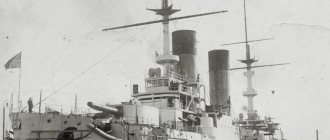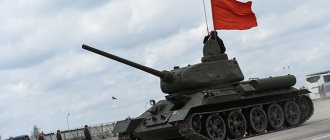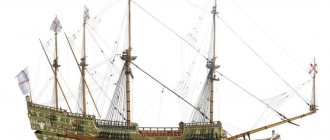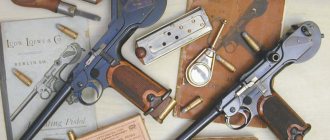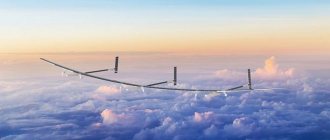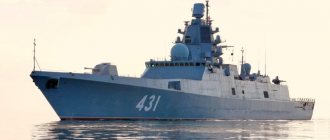The fleet has always occupied a special place in the structure of the armed forces of all countries. Service there was considered both honorable and difficult, and at the same time more dangerous than on land. Especially in the era of sailing ships, when the ship was completely dependent on the vagaries of nature, and in order to curb the wind, the crew had to make incredible efforts. And if at the same time it was also necessary to fight...
Initially, ships were used mainly only as a means of transporting troops. In Antiquity, the only combat technique available to triremes and penters was ramming an enemy ship. Then the art of boarding battles was mastered. But only with the advent of firearms did real warships appear, capable of fighting independently. From now on, every ship carrying cannons was a formidable force that had to be reckoned with. Over time, there were more and more guns and armor at sea, but fewer sails. Gradually the ships turned into real floating fortresses. Many ships have left their mark on the history of the navy. Today we present ten of the most notable among them.
Caracca "Santa Maria" (Spain)
Caracca "Santa Maria" (Spain)
Type: karakka. Displacement: 200 tons. Armament: 14 guns, 4 bombards. Team: up to 40 people.
The flagship of the famous expedition of Christopher Columbus, which resulted in the discovery of America, of course, was not a warship in the literal sense of the word. He did not take part in battles and did not distinguish himself in any war. However, it was the “Santa Maria” that was entrusted with the function of protecting Columbus’s flotilla from the unknown dangers that awaited the discoverers in the ocean.
The Santa Maria was a three-masted carrack (although it was long mistakenly considered a caravel). This type of ship appeared back in the 14th century and was ideally suited for long voyages. The large size and good stability ensured sufficient reliability during a storm, and the cannon armament was simply unprecedented at that time. In addition, a distinctive feature of the karakka was the powerful stern and bow superstructures, from which arquebusiers and crossbowmen fired. For this feature they were sometimes called “tower ships.” It was extremely difficult to board such a hulk, which made the Santa Maria a formidable force in the conditions of the then undeveloped art of naval combat. True, Christopher Columbus himself spoke critically of it, complaining about its slowness and poor maneuverability. Alas, the best ship from the flotilla of the discoverer of America died in the most ridiculous way. On Christmas Day 1492, he landed on reefs off the coast of Haiti.
"Hope"
Three-masted frigate, training vessel of the Federal State Unitary Enterprise "Rosmortport" (until 2014 it belonged to the Admiral G.I. Nevelskoy Maritime State University). Built in 1989-1991. commissioned by the Soviet Union in Gdansk (Polish People's Republic, now Poland). Every year it makes training voyages across the Pacific Ocean, visiting the ports of Japan, China and other countries in the Far Eastern region. Used for research purposes. Home port - Vladivostok.
— Vessel length 109.4 — m;
— Width — 14 m;
— Draft — 7.3 m;
— Displacement — 2 thousand 984 tons;
— Sail area — 2 thousand 768 sq. m;
— Sailing speed — up to 18 knots (33.3 km/h);
— Power plant — diesel, with a capacity of 1 thousand 224 horsepower;
— Crew — 50 sailors, 143 cadets.
Armored ship "Monitor" (USA)
Type: battleship. Displacement: 987 tons. Armament: two 279 mm cannons. Team: 59 people.
The ship, which later gave its name to an entire class of battleships, was created by Swedish emigrant John Erickson during the American Civil War in just 100 days. It was not the best of times for the northerners then - the Confederation was actively working on creating a powerful battleship that would be able to break through the naval blockade of southern ports. As a response, the hasty development of the “Monitor” began (this word meant “mentor”, and it was implied that he would “teach a lesson” to the southerners).
The ship had low sides and an armored deck, in the center of which was installed a large rotating gun turret, lined with multi-layer armor. The thickness of the turret armor reached 8 inches - at that time not a single Confederate gun could penetrate this. The shallow draft gave the Monitor the opportunity to operate on rivers and coastal shallows. But the low sides, which made the ship invisible, increased the risk of being flooded by waves. Despite a lot of shortcomings, the Monitor was put into operation and in March 1862 performed well in the battle at Hampton Roads. He was unable to sink the Southern battleship Virginia, but inflicted a number of damages on it, after which the Southern ship no longer took part in hostilities at sea. This showed the promise of using ships of this type. And the Monitor itself sank in December of the same year during a storm.
Battleship "Victory" (Britain)
Battleship "Victory" (Britain)
Type: 1st rank battleship. Displacement: 3500 tons. Armament: 104 guns (12-64 pounds). Team: about 1000 people.
This ship, which today has been turned into a museum and is permanently moored in Portsmouth, has seen a huge number of battles. At the Battle of Trafalgar she was the flagship of the famous Admiral Nelson. It was on board the Victory that Nelson was mortally wounded and died.
"Victory" was launched in May 1765, but it had the opportunity to enter battle for the first time only 13 years later. France in 1778 declared its support for the independence of the North American states. This led to another clash with Great Britain. In its first battle near the island of Ouessant (July 27, 1778), Victory set out immediately as a flagship. True, that battle did not bring glory to the English sailors. On the contrary, it turned out that the French were already quite capable of giving a worthy rebuff to the “lords of the seas.” Nevertheless, the advantage of the British fleet remained significant. At the Battle of Trafalgar on October 21, 1815, Victory was the most powerful British ship in terms of firepower. As you know, in this battle Britain did not lose a single ship (versus 18 from the enemy). However, the Victory was so seriously damaged that it had to be repaired in Gibraltar so that it could reach England under its own power. After that, he no longer took part in hostilities. And since 1922 it has been permanently parked.
Cruiser "Varyag" (Russian Empire)
Cruiser "Varyag" (Russian Empire)
Type: 1st rank armored cruiser. Displacement: 6604 tons. Armament: 36 guns (37-152 mm), 2 machine guns, mines, torpedoes. Team: 570 people.
The fate of this cruiser is truly paradoxical. He took part in only one battle, in which he did not have a single chance of victory, after which he was sunk by his crew. However, the moral victory of the Varyag team in the battle at Chemulpo was indisputable, which ensured both the sailors themselves and the ship true immortality. On February 9, 1904, the Varyag and the gunboat Koreets entered into battle with a Japanese squadron consisting of nine ships and fought with it for an hour. The Russian ships received serious damage, but were neither captured nor sunk. After this, Captain 1st Rank Vsevolod Rudnev decided to scuttle the cruiser and blow up the Koreets.
The Japanese raised the Varyag, repaired it and commissioned it as a training ship. At the same time, they showed deep respect for the Russian sailors - the name “Varyag” was retained on the stern (although officially the ship was now called “Soya”), and when rising on board the inscription was made: “On this ship we will teach you how to love your homeland." Subsequently, “Varyag” was again bought by Russia, but no longer took part in battles. Then, while undergoing repairs in Great Britain, it was confiscated for debts that the Bolsheviks refused to pay, and sold for scrap. Sank in the Irish Sea while being towed to a metal cutting facility.
Galleon "Vaza" (Sweden)
Type: galleon. Displacement: 1210 tons. Armament: 64 guns (1-24 pounds). Team: 445 people.
The Swedish king Gustav II Adolf dreamed of having at his disposal the most powerful ship among all that the Baltic Sea countries had. To implement this idea, work began in the spring of 1626 under the leadership of the Dutch shipwright Henrik Hubertsson. About 400 people were involved in the construction. The hull of the ship under construction was decorated with numerous carved figures. The result should have been not only a “monster of war”, but also a unique work of art.
The ship was completed by the beginning of 1628. He set off on his first voyage in August of the same year. But this voyage was his first and last. As soon as “Vaza” entered open water, a strong wind began to roll it over on its side. At first it was possible to straighten the list, but after a new powerful gust of wind the ship fell on board again and began to sink. Although everything happened close to the shore, due to the suddenness of the disaster, not all crew members could be saved - at least 50 people died.
The investigation that began revealed that the cause of the disaster was a design error. The “Vase” had a center of gravity too high, which made it extremely unstable. Ironically, there was no one to hold accountable for this failure: Hubertsson died before construction was completed, and all calculations were personally approved by the king.
Cruise ship Disney Dream
The ship is the property of a subsidiary of a major media conglomerate. Built in 2015. Up to 4 thousand guests can be accommodated on board. This place is ideal for those who want to find themselves in a fairy tale.
Disney Dream looks very unusual. The body is painted black and decorated with gold ornaments. There are images of Mickey Mouse on the red pipes. The interior decoration is striking in its luxury in the style of the 30s. Each public area is dedicated to a specific fairy tale or Disney film. Sports entertainment, numerous swimming pools, recreation areas, restaurants, cinemas and lounges - here everyone will find entertainment to their liking. Unfortunately, for most people, such a cruise is as out of reach as the fabulous life of Disney...
0 0
Battleship Missouri (USA)
Type: battleship. Displacement: 57,000 tons. Armament: 21 guns (127-406 mm), cruise missiles, anti-aircraft gun, helicopters. Team: 2800 people.
The last ship in the series of battleships, the Iowa, was ordered by the American Navy even before the United States entered World War II, but was built and launched already in 1944. Nevertheless, he managed to prove himself in the Pacific Theater of Operations. Here he mainly accompanied aircraft carrier formations. He took part in many famous operations - for example, providing artillery support during the landing on Iwo Jima and the assault on Okinawa. The Missouri went through many battles and was even attacked by a kamikaze. True, the suicide plane did not harm the ship.
The battleship's finest hour came on September 2, 1945, when the act of surrender of Japan was signed on board by representatives of the American and Soviet command. This is how the Second World War ended, but not the service of the Missouri. At first it was put into reserve and used for training purposes for almost 30 years. But after modernization in 1986, the battleship returned to service and fought some more. The last time its guns were heard was in 1991 during the Gulf War. After that, it was finally withdrawn, first from combat service, and then from the reserve, turning into a museum, permanently parked in Pearl Harbor.
Battleship "Mikasa" (Japan)
Type: squadron battleship. Displacement: 15,140 tons. Armament: 50 guns (47-305 mm), 4 torpedoes. Team: 836 people.
The best battleship of the Japanese fleet during the war with Russia was distinguished by good seaworthiness. Perhaps that is why Admiral Togo Heihachiro chose it as his flagship during the Russo-Japanese War. In addition, the Mikasa was one of the newest ships at that time - it was commissioned only in 1902. He took part in all the notable naval engagements of this conflict - the attack on Port Arthur, the battle in the Yellow Sea and, of course, the Battle of Tsushima. At the same time, in none of them did he receive a single serious injury, although only at Tsushima the guns of Russian ships hit the Mikasa more than forty times.
The battleship sank six days after the end of the Russo-Japanese War as a result of an accidental explosion in the aft powder magazine. In this case, 251 people were killed and at least 340 team members were injured. The ship sank to the bottom at a depth of 11 meters. They were not able to lift him right away. Repairs took two years, after which Mikasa continued to serve in the Japanese fleet. During the First World War, he patrolled the coastal waters of Japan. It was also used to support Japanese intervention in Russia during the Civil War. In 1923, the old battleship was removed from the fleet and turned into a museum. In this capacity, he was bombed by American aircraft during the Second World War. It was restored only in 1958-1961.
1) Titanic
The most famous sunken ship is the unfortunate Titanic
, about which many films and television programs have been shot and whose history is known to everyone, young and old.
This shipwreck has haunted researchers around the world for 100 years. Dubbed “unsinkable,” the Titanic
was unable to withstand the forces of nature and on April 14, 1912, collided with an iceberg and sank to the bottom, taking with it 1,517 men, women and children.
The wreck of the ship was discovered only in 1985 after a long search and today is under the protection of UNESCO.
Sloop "Vostok" (Russian Empire)
Type: sloop. Displacement: 985 tons. Armament: 28 guns (120-137 mm). Team: 117 people.
Another warship that did not take part in any battle, but went down in history. It was on the sloop "Vostok" (accompanied by its "younger brother" - the sloop "Mirny" under the command of Mikhail Lazarev) that Thaddeus Bellingshausen discovered a new continent - Antarctica. The sloop left the stocks of the Okhta Admiralty in St. Petersburg in 1818, and in the summer of 1819 it literally went to the ends of the world. This journey, which lasted three years, was in no way inferior in complexity and danger to a military campaign. The ship and crew were threatened by unknown currents, winds and icebergs, and not by the guns of enemy ships.
In 751 days, the ships covered 49,723 nautical miles (that is, more than 92 thousand kilometers). In addition to Antarctica, Russian sailors discovered and mapped 29 islands and made important oceanographic observations. Alas, the journey turned out to be so difficult that already in 1828 the Vostok was declared dilapidated, excluded from the lists of the fleet and dismantled. But the memory of it remained alive - several islands and a coast in Antarctica were named after the ship. The name "Vostok" was later given to a research station on the sixth continent, as well as a series of spaceships and a mountain range on Mercury. By the way, next to the latter there is a mountain range named after the sloop Mirny.
Liner Oasis Of The Seas
Belongs to the class of the largest ocean-going ships. It is owned by the cruise company Royal Caribbean International. “Registered” in the Bahamas, port of Nassau.
The appearance of the liner is its calling card, because it is intended for relaxation and entertainment. A huge (16-deck) snow-white ship is a floating city. It is capable of accommodating 5,400 passengers. There are plenty of activities to choose from, and the inside of the ship is just as beautiful as the outside. Swimming pools, two surf stimulators, a basketball arena and an ice skating rink - for those who love sports. Casinos, bars, musicals for nightlife lovers. Lots of entertainment for families with children. A spa area, shops, a private beach and even a park with trees... The splendor of Oasis Of The Seas will not leave anyone indifferent.
Battleship Bismarck (Nazi Germany)
Type: battleship. Displacement: 50,900 tons. Armament: 20 guns (150-380 mm), anti-aircraft guns, aircraft. Team: 2200 people.
The famous “hunt for the Bismarck” is one of the most striking and dramatic episodes of the Second World War that took place at sea. However, everything connected with this ship was destined to become a notable event. After all, at the time of its service, Bismarck was the largest battleship in the world. It is not for nothing that Adolf Hitler was personally present when it was launched on February 14, 1939.
The Bismarck set out on its first (and, as it turned out, last) cruise together with the heavy cruiser Prinz Eugen on May 18, 1941. They were supposed to attack one of the Allied Atlantic convoys. Soon the British spotted them and went to intercept them. Early in the morning of May 24, a battle took place in the Denmark Strait, as a result of which the English battlecruiser Hood was sunk. But the Bismarck was also damaged. The Germans split up and the Bismarck attempted to reach the French port of Brest alone. However, the British staged a real hunt for the German battleship. For a very long time they could not intercept him. The decisive role was played by a torpedo from the aircraft carrier Ark Royal, which disabled the Bismarck's rudder and forced it to slow down. After this, the ship was doomed. The British squadron arrived in time and finished it off, and on May 27 at 10:39 the ship, riddled with shells, sank to the bottom.
CSS Hunley
Americans are proud of this ship. It was built in 1863 by the Confederates during the War with the Union. CSS Hunley became the prototype submarine. With the help of this ship it was planned to mine and sink enemy ships. During the strength tests, 13 volunteer testers drowned. Among them was the designer of the ship, H. L. Hanley. The first successful dive occurred on February 17, 1864. The submersible sneaked up on the Housatonic, a Union vessel, and successfully sank it with a torpedo. Housatonic became the first ship in the world to be successfully torpedoed by a submarine. But the submarine did not return from combat duty. None of her team members escaped either. 136 years later she was discovered lying at the bottom of Charleston Harbor. The ship was placed in a special tank, where it awaits restoration.
Battlecruiser Goeben (German Empire)
Type: battle cruiser. Displacement: 25,400 tons. Armament: 34 guns (28-150 mm), 4 torpedo tubes. Team: 1425 people.
This giant earned the reputation of being the dreadnought ship that remained in service longer than any of her peers. Commissioned in 1914 as the flagship of the Mediterranean Group of the Kaiser's Fleet, she ended her service in 1973. True, already as the flagship of the Turkish Navy and under the name “Yavuz Sultan Selim”. It received this name and status of a Turkish ship at the beginning of the First World War. This was a clever trick so that the German cruiser could pass through the Bosporus and Dardanelles with the formal neutrality of Turkey.
Throughout the First World War, “Goeben” actively fought against Russia. He shelled Sevastopol, Batum and Tuapse, and repeatedly engaged in battle with Russian ships. Initially, the appearance of "Goeben" greatly shook the balance of power in favor of Germany. But after Russian battleships, significantly superior to the German cruiser, appeared in the Black Sea, the situation changed. After the war, the cruiser remained with Turkey, which was supposed to give it to England as part of reparations. However, the young Turkish Republic refused to fulfill this agreement and the Yavuz Sultan Selim was listed as the flagship of the Turkish fleet until 1950. In 1973, the Turks offered the Germans to buy the hopelessly outdated ship in order to turn it into a museum. Germany refused, and the veteran was cut to pieces.


